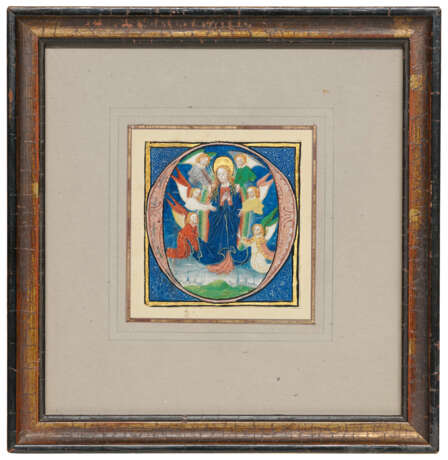ID 993241
Lot 14 | Follower of the Masters of the Gold Scrolls
Estimate value
£ 2 000 – 3 000
The Assumption of the Virgin, historiated initial ‘O’ cut from an illuminated choirbook on vellum [Bruges, c.1460s]
A charming example of southern Netherlandish illumination of the mid-15th century.
75 × 60 mm, a cutting, the initial ‘O’ likely opening the Feast of the Conception 'Ortus conclusus es dei genitrix', depicting six angels carrying the Virgin Mary in a mandorla to heaven, a hazy cityscape visible in the distance (cut to shape, a few smudges to the stave, else in excellent condition). Mounted on card and framed.
Illumination:
The illumination owes a debt to the Masters of the Gold Scrolls who dominated manuscript illumination in Bruges from the 1410s to the 1450s, and is reminiscent of the work of the Master of the Lee Hours (active c.1450-1470), who takes his name from his contribution to a Book of Hours once in the collection of Ronald Lee, originally illuminated for Charles the Bold of Burgundy and his wife Isabelle of Bourbon. The doll-like faces of the Virgin and the Angels recall the style of the Masters of the Beady Eyes (Maitres aux Yeux-Bridés), named for their distinctive manner of delineating eyes with firm dark lines and a beady dot. A very similar composition - also an initial 'O' with the Assumption - by a follower of the Master of the Lee Hours was sold at Christie's, 14-28 April 2021, lot 7. The figures and the stave decoration are also very close to an initial dated 1471 attributed to followers of the Masters of the Gold scrolls, sold at Sotheby's, 8 December 2015, lot 37.
Special notice
This lot is offered without reserve.
| Artist: | Masters of the Gold Scrolls (XV century - XV century) |
|---|---|
| Place of origin: | Western Europe, Europe, The Netherlands |
| Auction house category: | Medieval & renaissance manuscripts |
| Artist: | Masters of the Gold Scrolls (XV century - XV century) |
|---|---|
| Place of origin: | Western Europe, Europe, The Netherlands |
| Auction house category: | Medieval & renaissance manuscripts |
| Address of auction |
CHRISTIE'S 8 King Street, St. James's SW1Y 6QT London United Kingdom | |
|---|---|---|
| Preview |
| |
| Phone | +44 (0)20 7839 9060 | |
| Buyer Premium | see on Website | |
| Conditions of purchase | Conditions of purchase |





